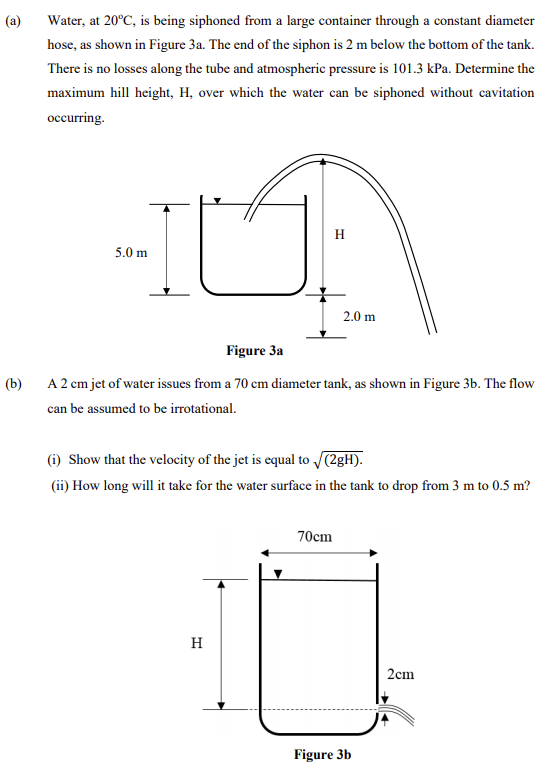(a) Water, at 20°C, is being siphoned from a large container through a constant diameter hose, as shown in Figure 3a. The end of the siphon is 2 m below the bottom of the tank. There is no losses along the tube and atmospheric pressure is 101.3 kPa. Determine the maximum hill height, H, over which the water can be siphoned without cavitation occurring. H 5.0 m 2.0 m Figure 3a
(a) Water, at 20°C, is being siphoned from a large container through a constant diameter hose, as shown in Figure 3a. The end of the siphon is 2 m below the bottom of the tank. There is no losses along the tube and atmospheric pressure is 101.3 kPa. Determine the maximum hill height, H, over which the water can be siphoned without cavitation occurring. H 5.0 m 2.0 m Figure 3a
Elements Of Electromagnetics
7th Edition
ISBN:9780190698614
Author:Sadiku, Matthew N. O.
Publisher:Sadiku, Matthew N. O.
ChapterMA: Math Assessment
Section: Chapter Questions
Problem 1.1MA
Related questions
Question

Transcribed Image Text:(a)
Water, at 20°C, is being siphoned from a large container through a constant diameter
hose, as shown in Figure 3a. The end of the siphon is 2 m below the bottom of the tank.
There is no losses along the tube and atmospheric pressure is 101.3 kPa. Determine the
maximum hill height, H, over which the water can be siphoned without cavitation
occurring.
H
5.0 m
2.0 m
Figure 3a
(b)
A 2 cm jet of water issues from a 70 cm diameter tank, as shown in Figure 3b. The flow
can be assumed to be irrotational.
(i) Show that the velocity of the jet is equal to (2gH).
(ii) How long will it take for the water surface in the tank to drop from 3 m to 0.5 m?
70cm
H
2cm
Figure 3b
Expert Solution
This question has been solved!
Explore an expertly crafted, step-by-step solution for a thorough understanding of key concepts.
This is a popular solution!
Trending now
This is a popular solution!
Step by step
Solved in 2 steps with 2 images

Knowledge Booster
Learn more about
Need a deep-dive on the concept behind this application? Look no further. Learn more about this topic, mechanical-engineering and related others by exploring similar questions and additional content below.Recommended textbooks for you

Elements Of Electromagnetics
Mechanical Engineering
ISBN:
9780190698614
Author:
Sadiku, Matthew N. O.
Publisher:
Oxford University Press

Mechanics of Materials (10th Edition)
Mechanical Engineering
ISBN:
9780134319650
Author:
Russell C. Hibbeler
Publisher:
PEARSON

Thermodynamics: An Engineering Approach
Mechanical Engineering
ISBN:
9781259822674
Author:
Yunus A. Cengel Dr., Michael A. Boles
Publisher:
McGraw-Hill Education

Elements Of Electromagnetics
Mechanical Engineering
ISBN:
9780190698614
Author:
Sadiku, Matthew N. O.
Publisher:
Oxford University Press

Mechanics of Materials (10th Edition)
Mechanical Engineering
ISBN:
9780134319650
Author:
Russell C. Hibbeler
Publisher:
PEARSON

Thermodynamics: An Engineering Approach
Mechanical Engineering
ISBN:
9781259822674
Author:
Yunus A. Cengel Dr., Michael A. Boles
Publisher:
McGraw-Hill Education

Control Systems Engineering
Mechanical Engineering
ISBN:
9781118170519
Author:
Norman S. Nise
Publisher:
WILEY

Mechanics of Materials (MindTap Course List)
Mechanical Engineering
ISBN:
9781337093347
Author:
Barry J. Goodno, James M. Gere
Publisher:
Cengage Learning

Engineering Mechanics: Statics
Mechanical Engineering
ISBN:
9781118807330
Author:
James L. Meriam, L. G. Kraige, J. N. Bolton
Publisher:
WILEY